BIOGRAPHY
CHANNING PEAKE, 1910-1989
Note: There are significant gaps in the biography of Channing Peake, and additional research is needed to provide a fuller picture of his life as an artist. For example, there is presently little information about the nature and extent of his exposure to modern art while living in New York in the mid-1930s. There surely was exposure, but the effects are not known. That caveat aside, the following information will be useful to persons inquiring into the life and work of Channing Peake. (PB)
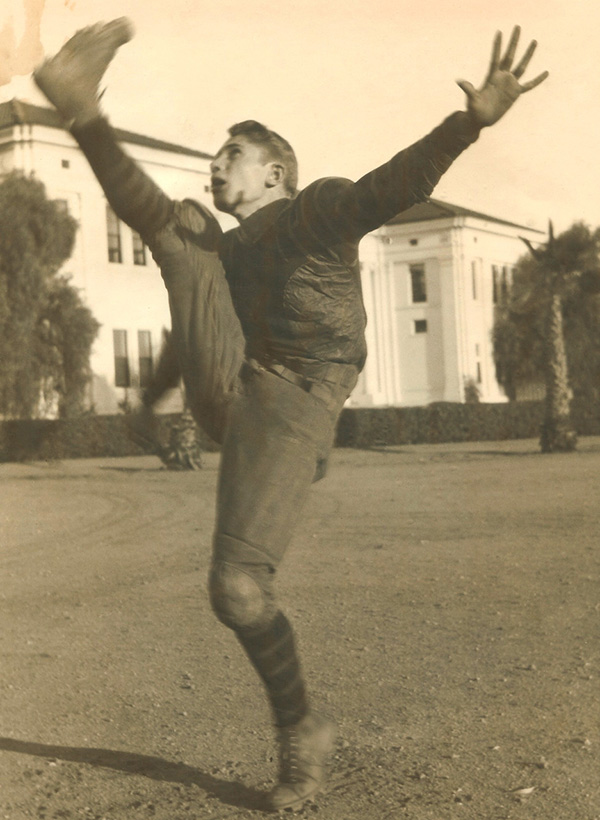
"Channing Peake, San Fernando High School
Football Star 1928"
CHILDHOOD
Channing Devine Peake was born on Oct. 24, 1910 in Marshall, Colorado to Charles and Nellie Peake. A sister, Genevieve, was born in 1913. During Peake’s early years his parents moved to the small mining town of Keeler, on the eastern flank of the Sierra Nevada Mountains in Inyo County, California. A few years later, the family moved again, this time to the San Fernando Valley in Los Angeles. Peake attended San Fernando High School from 1925 to 1928. His art teacher was the noted photographer and artist Barbara Morgan. Morgan recognized Peake’s talent and took an interest in him. Without his knowledge, she entered his work in a competition for a scholarship at the California College of Arts and Crafts in Oakland. At that time the school awarded two scholarships a year, one to a promising young artist in Northern California and another to an outstanding high school art student in Southern California. Peake was surprised and delighted when he learned that he had won the prestigious scholarship. However, he found himself in a quandary. In addition to being a gifted artist, he was an outstanding athlete, and the University of Southern California offered him a football scholarship. At age eighteen, Peake had to choose between art and sports. Art won out, and it became the focal point of his life.
ART EDUCATION
Peake’s time at the California College of Arts and Crafts would be relatively short. Not long after he began studies there, his family moved to Santa Barbara. The young artist liked the seaside community, and he felt drawn to the Santa Barbara School of the Arts, where a number of nationally prominent artists were offering classes. They included the American Impressionist Colin Campbell Cooper, the landscape painter Douglass Parshall, and the Western artist Edward Borein. Peake was able to secure a scholarship at the school, and he spent the next few years studying there. His work appeared in the school’s catalogues of 1929-30 and 1930-31. At this time, many young artists in the U.S. were excited by the mural movement that was underway in Mexico. Mexican artists like Diego Rivera, Jose Clemente Orozco, and David Alfaro Siqueiros—Los Tres Grandes—represented new options for artists in the arena of public art. Peake too was drawn to mural painting, and during his time at the Santa Barbara School of the Arts he was involved in at least one mural project. Working under the supervision of Edward Borein, and in the company of fellow students Joseph De Yong and Will James, he participated in a mural project at the Santa Barbara El Paseo Restaurant. In the early 1930s, Peake worked as an assistant to the noted silversmith George Steedman at Steedman’s Santa Barbara estate, Casa del Herrero. Steedman introduced him to Spanish Gothic design, which Peake later cited as an important influence in his artistic development. The strong, decisive outlining seen in Spanish art of the Gothic period, heightened by Byzantine influences that crept into Spain from Italy, afforded a solid basis for constructing a painting. While working for Steedman, Peake also painted a number of decorative motifs in the Casa del Herrero.
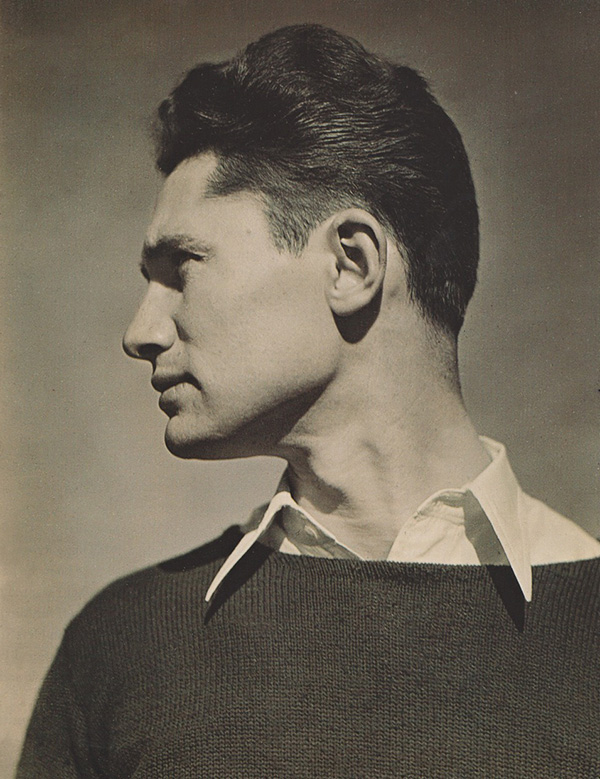
"A Portrait of the Artist as a Young Man”
By Brett Weston 1930s
JOURNEY IN THE AMERICAN SOUTHWEST
In 1932 Channing Peake made an extensive trip through Arizona and New Mexico. His experiences with Native American groups in the region stimulated a life-long interest in indigenous cultures. While in the Southwest, he corresponded with Joe De Yong, a Santa Barbara friend who was knowledgeable about Native American attire and saddles. Peake’s realistic drawings and small watercolors from the trip show a sure hand and an almost ethnographic eye for detail. His respect for native peoples is evident in dozens of drawings of Navajos, Hopis, and others engaged in the activities of daily life. Years later, Peake would become interested in the Lakota and other Plains tribes, and he would paint many powerful images of Plains warriors and shamans.
EARLY TRAVELS IN MEXICO
Eager to study mural painting, Peake set off for Mexico in the fall of 1934, initiating what would become a life-long interest in Mexico and Mexican culture. On that trip, he again traveled through the American Southwest, this time visiting ancient sites along the way, including the ruins at Betatakin. His Santa Barbara friend Dudley Carpenter accompanied him on the first leg of his journey.Arriving in Mexico in October, 1934, Peake was disappointed to learn that Jose Clemente Orozco, with whom he had hoped to study, was at that time out of the country. Peake then turned his attention to an other renowned muralist, Diego Rivera, who was painting a mural at the National Palace in Mexico City. He worked as an assistant to Rivera for a short time, but left when it became clear to him that Rivera was more interested in his female assistants than his male helpers. Convinced that Rivera would not be the mentor he had hoped, Peake headed south, toward Oaxaca. In Oaxaca, he explored the old Mixtec and Zapotec cultures. While staying at a hotel near the site of the excavation of the ancient Zapotec city of Monte Alban, he met Dr. Alfonso Caso, the eminent Mexican archaeologist who was in charge of the project. Peake was able to observe the dig at first hand. He watched excitedly as hundreds of archaeological treasures were unearthed. His experience at Monte Alban stimulated an enduring interest in Pre-Columbian pottery and sculpture. It also contributed to the development of his own artistic outlook, especially the mythic dimension of his work. Peake contracted malaria in Oaxaca and stayed there for several months while recuperating. His drawings from that time are realistic and show the same attention to detail and respect for indigenous cultures as his drawings of Native Americans in Arizona and New Mexico. Speaking little Spanish, he sometimes used drawings to communicate his needs.
STUDY AND WORK IN NEW YORK
New York was the next stop in Peake’s artistic journey. In the spring of 1935, at the age of 24, he boarded a ship in the Mexican port of Veracruz and set sail for New York, the center of the art world in the United States. In the summer and fall of that year he spent time at the artist colony in Old Lyme, Connecticut. In the fall he lived temporarily with Jack Hamilton, a friend from Santa Barbara, in his apartment at 136 West 55th Street in New York. While in New York, Peake studied briefly at the famous Art Students League. The league had been formed by forward-looking artists who were dissatisfied with the conservative instruction available at traditional schools. At the Art Students League, artists could design their own course of study and get the instruction they desired. Peake enrolled in the school in January of 1936, after learning of a mural painting class being offered by the Italian artist Frederico (Rico) Lebrun. Lebrun was a master draftsman with wide experience in fresco murals. His work often communicated an anguished and tragic view of life. Peake didn’t identify with the pathos in Lebrun’s work, but he admired his instructor’s powerful, animated style of drawing. Peake studied both fresco painting and life drawing with Lebrun while at the Art Students League. His residence at the time was studio #507 in the Van Dyke Studios, 939 West 8th Avenue. Lebrun sometimes used Peake’s studio for trysts, an arrangement that contributed to the dissolution of the Italian artist’s first marriage. While at the Arts Student League, Peake participated in two government-sponsored mural projects. First, he was selected from among several of Lebrun’s students to assist Lewis W. Rubenstein with a pair of-murals at the Germanic Museum at Harvard University. Rubenstein’s fresco murals depict 1) a scene from the Niebelung Legend featuring Alberich, the King of the Elves, and 2) a modern setting of the Norse Ragnarok legend, in which human life is regenerated on earth. The latter made symbolic reference to the effort to rebuild the American economy out of the financial ruins of the Great Depression. Peake began working on the project in the late spring or early summer of 1936. Following the Harvard project, Peake worked on another fresco mural, this time with Rico Lebrun himself. Lebrun asked Peake to assist on a mural for the postal annex at Pennsylvania Station in New York. Begun in late 1936, it was funded by the federal government, under a program known as the Treasury Art Project (TAP). The mural was composed of three sections: 1) a panel depicting a drought or dust bowl scene; 2) a panel titled “River Flood,” depicting the great flood in Johnstown, Pennsylvania in 1889; and 3) a panel showing a successful harvest. According to a newspaper account of the time, “The mural is intended to portray news that might come in a letter from the country.” The mural was never completed, however, likely because of changes in the design of the postal annex. Both the New York mural and the one at Harvard were realistic, done according to the then-popular canon of American Scene painting.
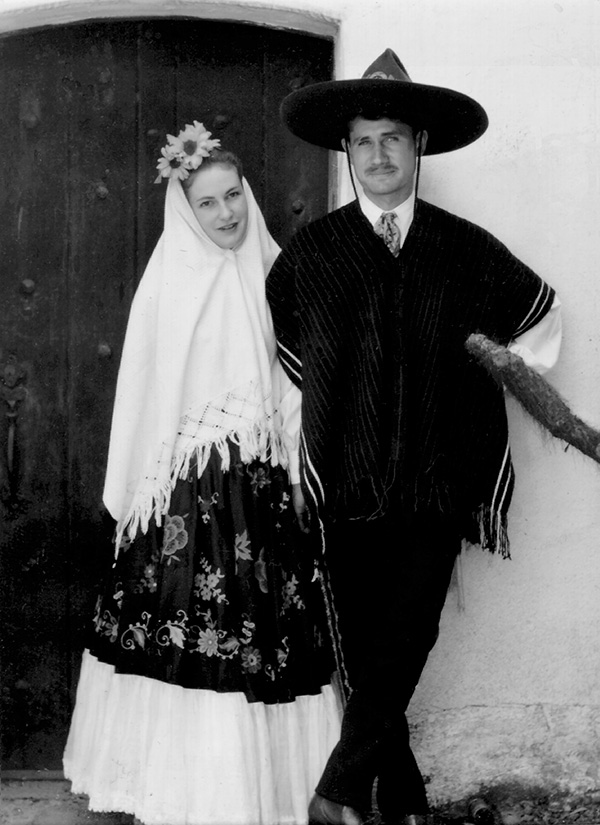
"Newlyweds Channing and Catherine captured during Santa Barbara Fiesta Celebration."
MARRIAGE TO CATHERINE SCHOTT
During his years in New York, Peake grew close to Catherine (Katy) Schott. He had met her a few years earlier in Santa Barbara, where the Schott family maintained a second residence. In fact, he had given Katy and one of her sisters art lessons in Santa Barbara. Catherine’s father, Max Schott, was a well-to-do mining entrepreneur and the owner of Climax Metals Company. Her mother, Alice Schott, had strong artistic interests and was also engaged in several social welfare projects. Peake was strongly attracted to the wealthy and cultured family, and he aspired to live in their privileged world. With his marriage to Catherine in 1938, Channing Peake gained entry to a way of life that would open many doors and give him the freedom to pursue his artistic purposes. During their marriage, Channing and Catherine Peake had four children. A daughter, also named Catherine, was born in 1938. Their only son, Michael, was born in 1940. A second daughter, Jacqueline, arrived in 1943, and a third daughter, Christina, was born in 1950.
THE RANCHO JABALI
Following their marriage, Channing and Catherine Peake returned to Santa Barbara, where they quickly became involved in ranching activities. Katy was an avid horsewoman and had long been attracted to ranch life. Using part of her inheritance, they purchased 1,600 acres in Buellton, California part of the Santa Ynez Valley and established the Rancho Jabali. (“Jabali” means wild boar in Spanish.) Peake took to ranching with great interest and enthusiasm. His immersion in ranch life went so far as hunting wild boar with bow and arrows, sometimes in association with Los Rancheros Vistadores, a riding organization founded by Edward Borein, his former instructor at the Santa Barbara School of the Arts. Over the next twenty years (1939-1959), Peake would develop a deep bond with the Rancho Jabali. The place would provide a physical, psychological, and spiritual reference for almost every aspect of his life. It would also be a vital source of imagery and inspiration for his art. Peake remained a practicing artist while living on the Rancho Jabali. He was also active in cultural circles in Santa Barbara. In 1940 he became a founding member of the Santa Barbara Museum of Art. He served as a trustee of the museum until 1988, the year before his death.
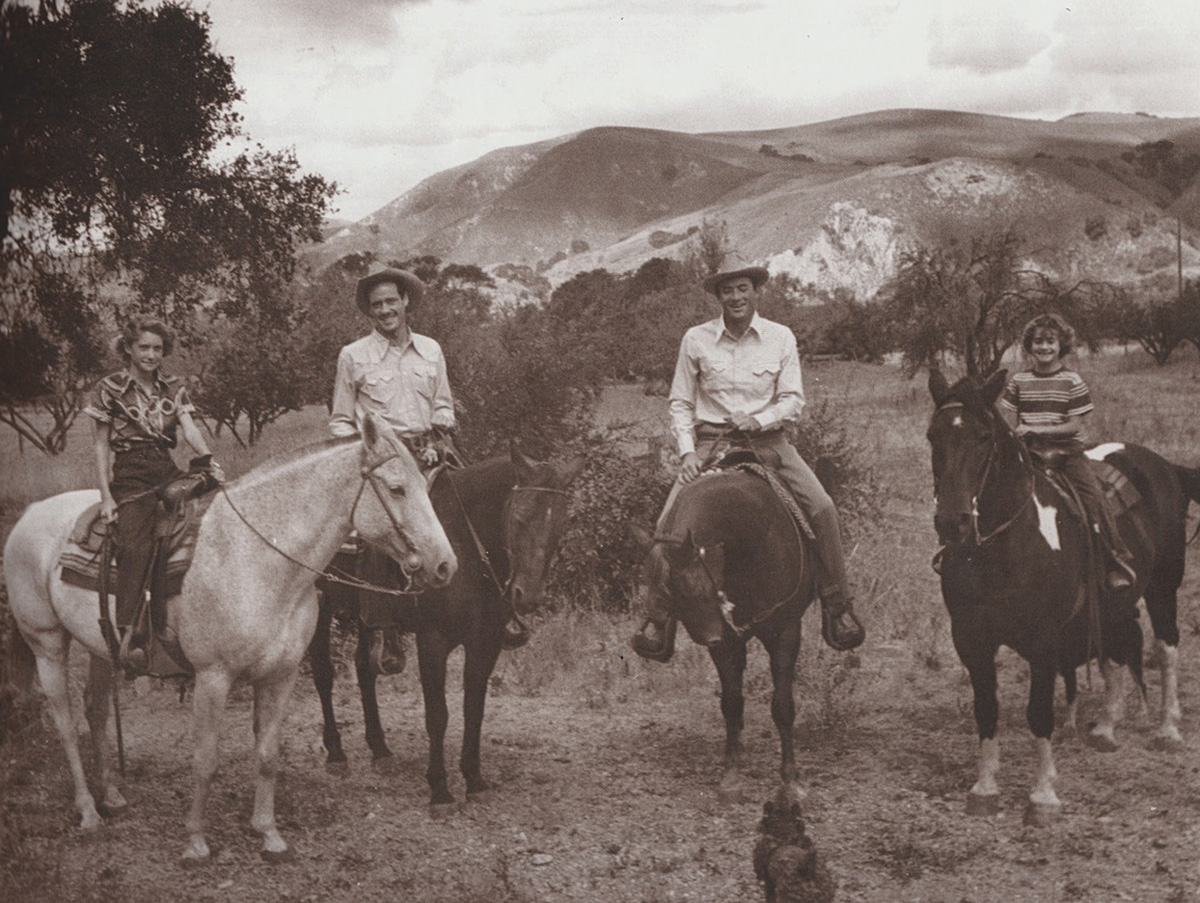
“Katherine Peake, Gregory Peck, Mel Ferrer, and Jackie Peake Out for a Ride” Rancho Jabali, 1950s
WAR YEARS
At the beginning of World War II, Peake received an agricultural deferment (exemption from service), based on his ranching and farming activities, which were deemed vital to the national mobilization. During the war years he was reunited with Rico Lebrun, his instructor at the Art Students League, who had moved to Los Angeles. In Southern California Lebrun taught drawing at two art schools: Chouinard Art Institute and the Jepson Art Institute. He was a frequent visitor at the Rancho Jabali during the war years. In 1945, Donald Bear, the Director of the Santa Barbara Museum of Art, invited Lebrun to serve as artist-in-residence at the museum. Lebrun introduced Peake to the artist Howard Warshaw, who also became a regular visitor at the Rancho Jabali. Born and educated in New York, Warshaw had studied at Pratt Institute and the Art Students League. He moved to Los Angeles in 1942. Once attracted to Surrealism (he was a friend of the surrealist painter Eugene Berman), Warshaw later became interested in conveying motion in his work through the use of multiple simultaneous perspectives. Through Rico Lebrun, Warshaw gained an organic Cubist framework that he used in much of his mature work. Howard Warshaw and Channing Peake were friends until Warshaw’s untimely death in 1977 at the age of 56.
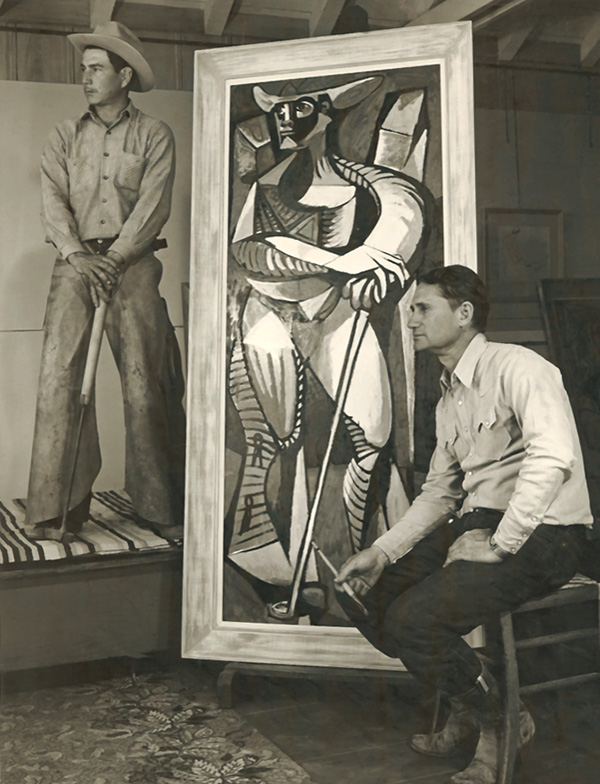
"Channing Peake in his Studio at Rancho Jabali“ 1950
ARTIST AND COWBOY
During the 1940s and 1950s, Peake divided his time between running the ranch, raising a family, and pursuing his artistic interests. Over that time, he developed an original vision and a highly personal style. At the heart of his work in those years was a deep fascination with the forms he observed on the ranch and in the surrounding countryside—the lines and volumes of the Santa Ynez Mountains, the geometry of the ranch buildings in the valley below, the eccentric, angular shapes of the farm implements, cowboys busy at their tasks, and of course the animals, the ubiquitous animals. Using these forms as starting points, and working within a loose, Cubist-derived framework, he abstracted them freely. Color became a primary compositional device, as well as a potent expressive force. The objects lost their original identity as Peake practiced painting as an act of transformation, a kind of alchemical adventure. All the while, he maintained a careful balance between ranching and painting. To him, there was no separation between the two; he loved both and found them to be compatible and complementary. While Peake looked to Cubism for useful structural devices, he was also drawn to Abstract Expressionism. The New York-based movement exerted a powerful influence in American art at the very time Peake was elaborating his personal visual language. His animated depictions of mechanical objects in the late 1940s and 1950s also reveal an interest in Biomorphism. In many paintings of that time, he transformed inanimate objects into living, breathing organisms. At the same time, Peaked continued to do representational drawings. His love of anatomy and draftsmanship can be seen in ink drawings of cowboys and livestock at the Rancho Jabali.
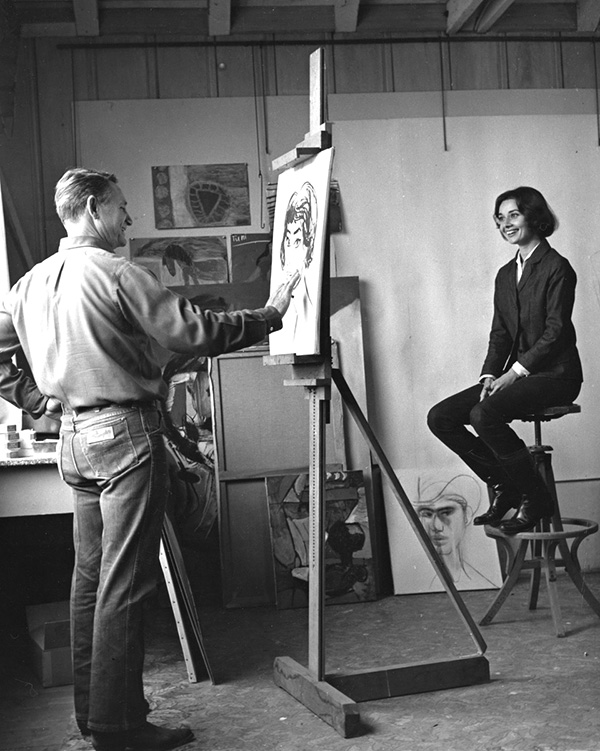
"Channing Peake Drawing his Friend Audrey Hepburn"
EARLY CRITICAL ATTENTION
In the late 1940s and early 1950s, Peake began to attract favorable critical attention. In April of 1948 he exhibited several paintings in a show at the Pasadena Art Institute (now the Norton Simon Museum). Reviewing the exhibition, Arthur Millier, art critic of the Los Angeles Times, noted that, “All this reviewer knows about Channing Peake is that he lives in Santa Barbara, has studied with Rico Lebrun and is doing painting which for sheer force of design and color has no parallel on the Coast, perhaps in the country.” In October of that year Peake exhibited work with Howard Warshaw and Milton Zolotow at the Gallery of Mid-20th Century Art in Beverly Hills. In 1950 his work was selected for an exhibit at the Los Angeles County Museum (now LACMA). It caught the attention of the prominent art dealer Frank Perls, who offered to represent him. In October, 1950 Peake had his first one-person show at the Frank Perls Gallery in Beverly Hills. This was followed in 1951 by a one-man show in the Van Romberg Gallery at the Santa Barbara Museum of Art. Frank Perls became increasingly interested in Peake’s work, featuring it in another show in 1953 and inviting Peake to accompany him on a European buying trip. In that same year, Perls introduced Peake to Pablo Picasso and Françoise Gilot at their home in Vallauris on the Côte d’Azur in southern France. According to Perls, Peake made a favorable impression on Picasso. Their connection may have been reinforced by a shared love of drawing horses and bulls. Peake gave Picasso a cowboy hat, which the legendary artist relished and which can be seen in a number of photos of Picasso taken at that time. Frank Perls would go on to introduce Peake to many other noted artists, including Rufino Tamayo and Man Ray. In the 1950s Peake became something of a sensation in the Los Angeles film community. He enjoyed close friendships with several actors, including Gregory Peck, Mel Ferrer, and Audrey Hepburn, and his work was collected by such prominent figures as Edward G. Robinson, Vincent Price, Patricia Neal, Dorothy McGuire, and Ann Baxter. For some of these Hollywood notables, the Rancho Jabali became an attractive hideaway, a place where they could relax outside the gaze of prying reporters and fans.
1957 LEBRUN / PEAKE / WARSHAW EXHIBIT
There were multiple connections between Channing Peake, Rico Lebrun, and Howard Warshaw, stretching from New York to Los Angeles. Despite having different styles and thematic interests, the three men shared a humanistic orientation toward art, and they all employed a Cubist framework for the spatial organization of their paintings. Moreover, they all enjoyed painting at the Rancho Jabali. In recognition of their loose association, the Santa Barbara Museum of Art and the M.H. de Young Memorial Museum in San Francisco organized an exhibit entitled “Three Painters.” It opened in Santa Barbara in early December of 1956 and in San Francisco in February of 1957. Art critic Henry J. Seldis wrote admiringly of the exhibit, noting that its power “can be attributed to the ability of these painters to demonstrate conclusively that that the image in painting can be preserved without resorting to 19th century mannerisms and without limiting their experimentation and search toward new ways of seeing and painting.” That same year, 1957, Peake was given an exhibit at the San Luis Obispo Art Association. It was notable for the inclusion of actual farm implements, the source of much of Peake’s imagery. The 1957 exhibit was highlighted in a 2012 show at the San Luis Obispo Museum o f Art, entitled A Time and A Place: The Artistic Encounter Between Channing Peake and Elaine Badgley Arnoux.
DON QUIXOTE MURAL
In 1958 Channing Peake and Howard Warshaw won a competition to design a large mural for the Santa Barbara Public Library. They took as their inspiration the story of Don Quixote de la Mancha by the Spanish novelist Miguel de Cervantes. Peake and Warshaw divided the work in half, each giving his interpretation of two scenes from the novel. In the first scene, Peake depicted Don Quixote and his companion, Sancho Panza, perched on their steeds. In the second scene, he showed the vainglorious knight charging a herd of cattle, which he had mistakenly interpreted as a troop of enemy cavalry. Peake’s strength as a designer and his ability to create powerful imagery on a large scale are clearly evident in this mural, which is still on display in the library. (Originally designed for installation in an exterior patio, the mural was moved to an interior location when the library was remodeled.)
DEPARTURE FROM RANCHO JABALI / MOVE TO PARIS / SECOND MARRIAGE
In 1959, Channing Peake ended his marriage to his first wife, Catherine. Longstanding marital difficulties contributed to the divorce, as did Peake’s desire to devote more attention to his art. They sold a large portion of the Rancho Jabali, ending a rich and productive chapter in their lives. After the breakup, Peake worked briefly in San Francisco, using a studio in the city’s North Beach district. Then, in December of 1959, he moved to Paris, where he rented a studio on the famous Rue Lepic in Montmartre. Such artists as Edgar Degas, Vincent Van Gogh, Henri de Toulouse-Lautrec, and Max Ernst once maintained studios on Rue Lepic. Eager to explore new territory, Peake plunged deeply into non-objective painting, something he had begun in San Francisco. In Paris, his paintings became more ephemeral and mystical, yet they retained the elemental power of his earlier work. He created fields of pulsating color, represented by dots and daubs of paint, often with an overlay of calligraphic markings, which sometimes alluded to earlier formal elements in his paintings of farm machinery. His focus was now the thin veil between form and formlessness. At the same time, he experimented with the addition of marble dust to the painted surface. Peake received shows at two Parisian galleries during his days in France: Galerie Zak and Knoedler Gallery. Rufino Tamayo saw Peake’s work at Galerie Zak, admired it, and offered to let Peake use his Paris studio while he was away in Spain. In 1960 Peake married his second wife, Joelle Mazet, then an 18-year-old ballerina living in Paris. Peake’s good friend Gregory Peck served as best man at their wedding.
RETURN TO CALIFORNIA / THIRD MARRIAGE / MOVE TO MEXICO
Despite the two exhibits in Paris and his marriage to Joelle Mazet, Channing Peake felt increasingly adrift in France, saying later that “Paris didn’t feed me.” He returned to California, this time taking up residence in Los Angeles. There, he began new artistic experiments, now influenced by jazz and popular culture. Peake’s Los Angeles paintings feature flat, opaque, brightly colored forms, reflecting the Pop imagery and colors of the 1960s. His marriage to Joelle Mazet ended in 1962. The following year (1963) he married a Los Angeles socialite, Harriet Thurtle Bundy, who became his third wife. The couple subsequently moved to Morelia, Mexico, where they lived for the better part of two years. Working in a studio at the Villa Montana in Morelia, Peake changed artistic direction yet again. He turned his attention back to the natural world, finding inspiration in the plants and animals around him, much as he had years earlier at the Rancho Jabali. He painted cacti and grasshoppers and other earthy subjects, often in hauntingly dark tones. His style at this time reflects his earlier interest in Abstract Expressionism.
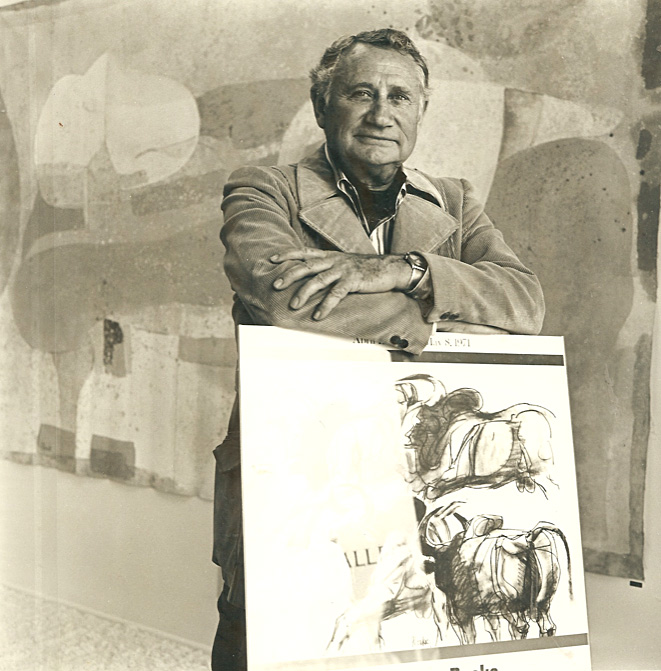
“Channing Peake Celebrating His Opening at the Mary Moore Gallery.”
WORSENING ALCOHOLISM / FIDELITY TO HIS ART
Peake had productive periods in his studio at the Villa Montana in Mexico, but his abuse of alcohol became increasingly pronounced and destructive while living there. It significantly undermined relationships with friends and relatives, as well as with persons in the art world. His marriage to Harriet Thurtle Bundy was but one of many casualties. It ended in divorce in 1968. Despite the ravages of alcohol, Peake managed to remain faithful to his artistic muse. In 1969 he had an exhibit at the Toninelli Gallery of Modern art in Rome, and in 1970 he exhibited some of his sculpture at the Esther Bear Gallery in Montecito, California. A year later, in 1971, he showed his work in the inaugural exhibit at the Mary Moore Gallery in La Jolla. While there, he was reunited with Francoise Gilot, whom he had known in France many years earlier. At the time of the 1971 exhibit, she was married to Dr. Jonas Salk, founder of the Salk Institute in La Jolla. The Santa Barbara Museum of Art honored Peake with a retrospective exhibition in 1975. The exhibit included several large stain and drip canvases, which showed his continuing exploration of color field painting. Some of these works featured very flat surfaces, with portions of the canvas left raw, heightening the feeling of organic, color-defined form.
MARRIAGE TO CHERIE RABER / NEW SOBRIETY / FINAL WORK
In 1978, while working on a mural at the Santa Barbara Biltmore Hotel, Channing Peake met Cherie Raber, a young woman from Orange County, California. They were married in 1979, at which time Raber became Peake’s fifth and last wife. (Little is known about Peake’s short-lived fourth marriage, to a woman named Gloria Hanes.) Cherie Peake became a stabilizing influence in the artist’s life, helping him address his alcoholism and find a new sobriety. For the remaining ten years of his life, Peake drew from what had become his mature artistic vocabulary, developing and refining formal elements he had identified earlier. Throughout his career, Peake maintained a strong interest in murals and public art. He painted his last mural in 1984, for the El Paseo Restaurant in Santa Barbara. The mural now occupies a prominent position in the Santa Barbara Airport, welcoming visitors from around the world.
Channing Peake died on May 31, 1989 in Santa Barbara.